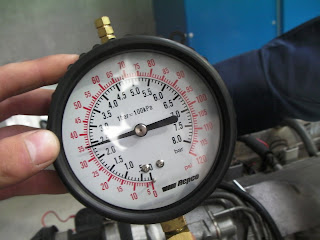Experiment
Pressure testing
Pressure testing is used to check the cooling system for leaks by pressurizing the coolant with air. If there is a leak the pressure will go down over time (the gauge will go down)
Radiator
The radiator was visually checked for signs of corrosion or damage. The cap is also checked for damage and pressure tested.
Damaged radiator
Coolant testing (specific gravity)
The coolant is checked using a hydrometer. It indicates if there is enough antifreeze in the cooling system and what stat it is in.
Hoses
The hoses are visually checked for signs of wear like cracks
Thermostat
The thermostat is checked to see if it opens and closes at the right temperature by taking it out of the engine and placing it is a pot of water that is at the manufacturer's specified temperature.
Fan
The working condition of the fan is checked by bypassing the fan switch. If the fan does not go on there may be a fault with the relay, wires or the fan its self. The fan can be connected to power directly to see if it works. The switch can be checked by getting the engine up to operating temperature while the car is stationery.
Water pump and belts
The water pump is checked by removing its drive belts and turning it by hand, it should turn smoothly if it doesn't it will need to be replaced. The drive belts are checked for wear and that they are correctly adjusted.
Reflection
The cooling system is very important to ensure that the engine works correctly. If the engine over heats it could blow the head gasket or cause the engine to seize. If the thermostat stays closed the temperature will increases until the engine over heats as it does not allow the coolant to go to the radiator. If the thermostat stays open or opens at the wrong temperature it may result in the engine taking a long time to get to operating temperature or it may stay at a low temperature. If the fan does not work the car will over heat while stationery.
























